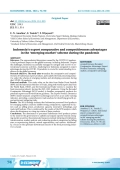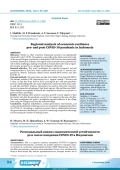Relevance. The unprecedented disruptions caused by the COVID-19 pandemic had a profound impact on the global economy, including Indonesia. Despite the challenges, Indonesia successfully managed to navigate and recover its international economic activities. Analyzing how Indonesia navigated its export advantages during the COVID-19 pandemic is crucial for understanding its resilience in the global economy. Research objective. The study aims to analyze the comparative and competitiveness of Indonesian export products, particularly the food processing industry, under the scheme of emerging markets and developing economies during the COVID-19 pandemic. Data and methods. This study relies on the data from Badan Pusat Statistik (BPS) and the Indonesian Ministry of Trade, along with world export data from the World Bank, OECD, and the International Trade Center, to examine the food processing industry during the 2021-2022 pandemic. Using the Revealed Comparative Advantage (RCA) model, it classifies comparative products for potential exports and diversification guidance. The Export Product Dynamics (EPD) model measures competitive advantage and serves as an early warning indicator, providing a comprehensive trade analysis for identifying growth opportunities and mitigating risks. Results. The RCA findings indicate that Indonesian processed food products for emerging market countries exhibit strong comparatives, supported by factors such as selling prices, production capacity, innovative technology, and trade tariff policies. This is reinforced by the results of the EPD analysis, which shows the dominance or rising star status of these products. Conclusions. The dominance of processed Indonesian food products points to the need for the government to uphold and expand exports beyond emerging market countries. Recommended measures include initiating revitalization, transformation, market analysis, and evaluating products categorized as falling stars or experiencing failures, missed opportunities, and retreats. Additionally, a focus on the upstream-downstream sectors of the food processing industry is crucial.
Relevance. Similar to other countries, Indonesia’s economy was significantly impacted by the COVID-19 pandemic, especially at the district and city levels. As the second-largest contributor to Indonesia’s GDP, East Java faced noticeable economic downturns. Industry, the region’s main economic sector, played a key role in these challenges, making it essential to evaluate all sectors from a regional economic perspective to navigate this turbulence effectively. Research objective. This study investigates the regional economy’s sectoral competitiveness in East Java, with a particular focus on the 17 sectors categorized by Statistic Indonesia (Badan Pusat Statistik-BPS) before and after COVID-19. Data and methods. The study relies on data from Badan Pusat Statistik (BPS)). The dataset includes GDP information for 11 regions, namely 7 districts and 4 cities, in East Java from 2018 to 2022, covering the pre- and post-pandemic periods. Methodologically, the study employed Location Quotient (LQ) analysis and Mix and Share Analysis. LQ analysis was used to assess the concentration and comparative advantage of East Java’s regions. Mix and Share and Shift-Share analyses were applied to identify the competitive industries in specific regions and their advantages. Results. The findings show positive economic growth in most regions of East Java before and after the pandemic, except for two regencies that saw a decline. The study emphasizes the need to strengthen regional resilience at the village level using the Village Fund from the national budget. Conclusions. Regional stakeholders, central government interventions, and continued development of leading sectors are essential for mitigating the effects of COVID-19. According to regional economic theory, collaboration between the government and businesses is crucial for enhancing competitive advantage and increasing the number of leading sectors.

